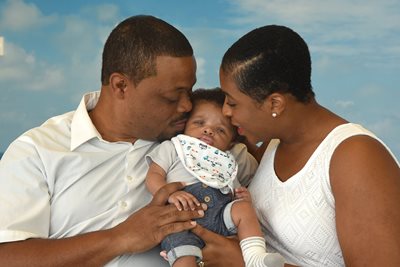Megan Perry had reached an exciting milestone in her pregnancy, the moment where she would learn if her first baby would be a girl or a boy. The anatomy scan, typically conducted between 18-22 weeks gestation, is a special time for many expectant parents and typically initiates name selection and baby shopping. But for Megan and her husband it was one of the most difficult days of their lives. The couple learned that their baby, a boy they hoped to name Logan, had a complex medical problem.
“They told us that the baby had a hole where his diaphragm should be, and that the intestines had moved into his chest cavity. It was devastating to hear,” she said.
Dr. Gonzalez Quintero, Perinatologist with Maternal Fetal Medicine of South Florida, referred the couple to Nicklaus Children’s Hospital’s Fetal Care Center to counsel the parents and create a plan for the baby’s care before, during, and after birth.
“Congenital diaphragmatic hernia (CDH) is a rare birth defect that affects 1 in 3,000 infants. The diaphragm, which forms between the 7 to 10th week of pregnancy, does not develop properly and some or all parts of the baby’s abdominal organs move into the chest,” said Dr. Saima Aftab, PSA Chief, Section of Neonatology, Perinatal Services and the Fetal Care Center at Nicklaus Children's.
“At first, we were very anxious but we knew we had to do our research and find the best possible treatment for our son,” said Megan.
The Perrys were able to schedule a visit with a team of specialists at Nicklaus Children’s the same week they learned of Logan’s diagnosis, including a surgeon, radiologist and neonatologist.
“I received a call from a nurse navigator that same day. She provided me with her cell phone number and advised I could call or text her with any questions. She also explained everything about our first appointment including where we should park, who we would meet and what the day would be like,” said Megan. Having that type of personalized support was special to us and truly made things a lot easier.”
The anxious mom-to-be underwent multiple tests, including fetal magnetic resonance imaging (fetal MRI) to obtain detailed information about the baby’s developing organs.
Dr. Esperanza Pacheco-Jacomé, Pediatric Neuroradiologist and Specialist in Fetal Imaging says, “Fetal MRI is a critical component of our care plan for infants like little Logan. This innovative technology allows us to obtain essential information about lung development and other associated abnormalities which help prepare the family, give them a sense of the outcome, and allow the medical team to anticipate a personalized medical care plan during and after delivery.”
The Perrys met with a team of specialists who together formed a plan for little Logan. She also toured the Neonatal Intensive Care Unit (NICU) at Nicklaus Children’s during her visit.
“It felt good to prepare and understand what to expect once I would give birth to my baby. I knew that he would be transferred to the children’s hospital and that I may not have the opportunity to breast feed right away,” said Megan.
Little Logan was born at 9 pounds, 3 ounces and spent three weeks in the NICU at Nicklaus Children’s where he underwent surgery to repair the condition.
Dr. Fuad Alkhoury, Director of Neonatal Surgery at Nicklaus Children’s and part of Miami Associates in Pediatric Surgery said, “We gently moved his abdominal organs down from the chest into where they should be. We then closed the hole in the diaphragm with a mesh-like material to keep everything in place. This allows the baby’s lungs to develop and grow in the right place.”

Logan proved to be a strong little one, surpassing anticipated milestones. Dr. Magaly Diaz-Barbosa, Director of the Division of Neonatology and Medical Director of NICU at Nicklaus Children’s says Logan’s recovery and outcome was one of the best she has seen in infants with CDH. In fact, he only spent three weeks in the NICU before returning home.
“Prenatal testing, diagnostic evaluations and careful planning are vitally important steps for infants with complex conditions. Thanks to these advances, our team was able to study Logan’s condition and carefully plan his treatment to ensure the best possible outcome.” As a result, he recovered exceptionally well, said Dr. Diaz-Barbosa.
“We are so happy to have him home to celebrate every little baby milestone. We can’t thank the team enough for their compassion, caring, kindness and expertise to ensure our little Logan has the best life possible,” said Megan.